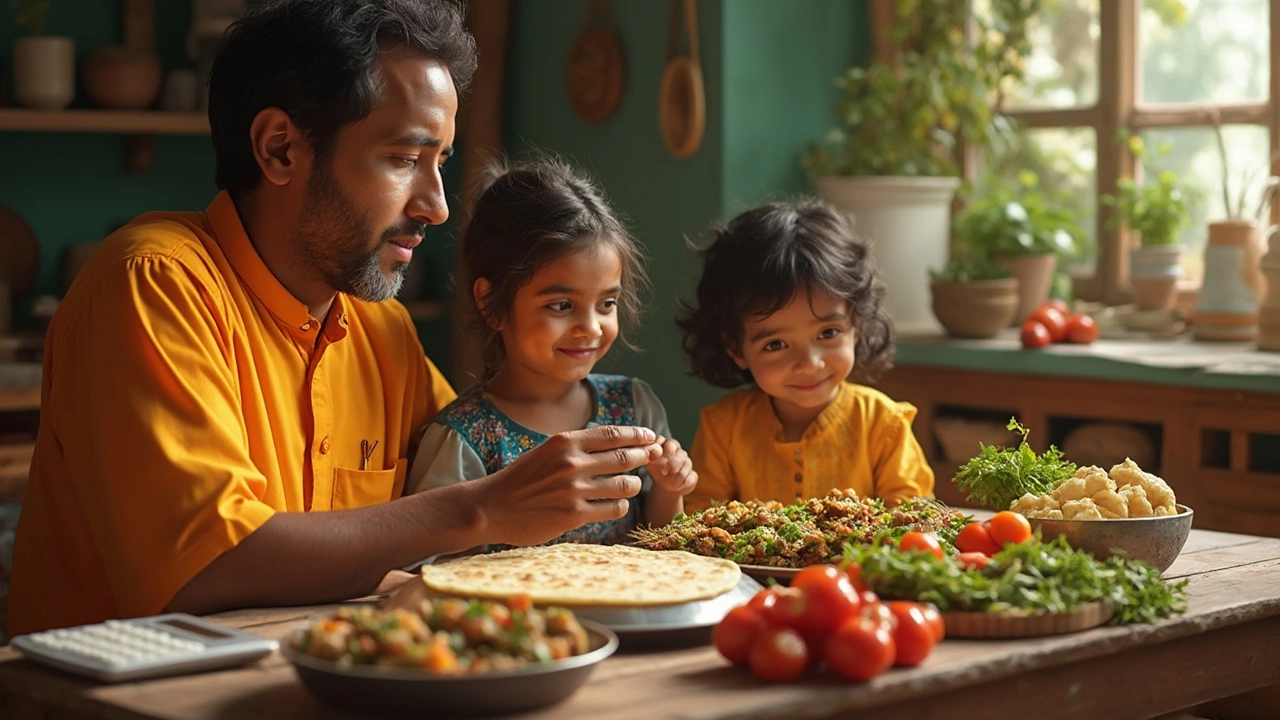How Many Chapatis Should You Eat in a Day? A Guide to Balanced Nutrition
 Feb, 28 2025
Feb, 28 2025
Trying to figure out how many chapatis to eat daily? Let’s start by understanding that not all of us need the same number. Factors like your activity level, metabolic rate, and overall health goals play a big role in this decision. A good starting point is knowing the calories in one roti, which usually contains about 70 calories. If you’re keeping an eye on your caloric intake or using a calorie calculator, this can be a useful nugget of info.
Before you decide your chapati quota, it’s wise to calculate your BMI or Body Mass Index. This little number gives you a snapshot of whether you’re underweight, normal weight, overweight, or obese. Your BMI can guide your daily calorie needs, and subsequently, how many chapatis you should tuck into each meal.
Thinking locally, we have different varieties of chapatis across regions, each adding its unique twist to nutrition. But, the universal rule holds: moderation and balance. Dive into your local nutritional guidelines to see where chapatis fit in your daily diet chart.
- Understanding Calories in Chapatis
- Determining Chapati Intake
- Legal and Cultural Perspectives
- Practical Tips for a Balanced Diet
Understanding Calories in Chapatis
Chapatis are a staple in many parts of the world, particularly in South Asia. They're simple to make and pack a decent amount of nutrition into every bite. The Calories in One Roti are crucial to consider if you’re aiming for balanced meals, especially in terms of carbs and energy levels.
On average, a homemade chapati contains about 70 calories. But not all chapatis are created equal! The calorie content might rise if you use more oil or ghee in the preparation. So, if you're trying to cut back on calories, sticking to dry roasting could be the best bet.
Steps to Calculate Chapati Calorie Content
- Start with basic ingredients. For one roti, you'll likely use about 30 grams of wheat flour.
- Check the flour package for detailed nutritional info, looking specifically at carbohydrates and fats.
- Add any other ingredients, like oil, butter, or salt, to the calculation. Every tablespoon of oil adds approximately 120 calories.
Using a calorie calculator can simplify this process, allowing you to customize based on specific ingredients like low-fat flour or alternative grains.
When it comes to legal and health guidelines, there’s no strict rule in most places about how many chapatis you should consume. However, some local dietary recommendations can provide helpful guidance. For example, in India, dietary guidelines often suggest fulfilling a significant portion of your energy needs through grains like chapatis.
Local Variations and Nutritional Value
Different regions also tweak the basic recipe to enhance flavor, from adding milk and spices to using alternative flours. These variations can impact calorie content. Being mindful of these differences is key to making an informed decision about your daily intake.
Here's an example of flour calories that aid in choosing alternatives:
| Flour Type | Calories per 100g |
|---|---|
| Whole Wheat | 340 |
| Buckwheat | 343 |
| Cornflour | 361 |
Remember, knowing how many Chapatis Should You Eat in a Day involves balancing your energy needs, meal portions, and health goals.
Determining Chapati Intake
Figuring out how many chapatis you should munch on involves a bit more than just hunger pangs. It's about calories, activity levels, and those nutrition goals you’re aiming for. Here’s a simple guide to help you get it right.
1. Know Your Caloric Needs
First, whip out that calorie calculator. Your daily calorie needs depend on factors like age, gender, weight, height, and how active you are. Once you’ve got that number, it’ll help guide your chapati count.
2. Calculate Calories from Chapatis
Next, it’s all about the math. One chapati roughly equals 70 calories. So, if you’re aiming for 1400 calories a day, maybe 4-5 chapatis might fit into your plan, depending on what else you eat. Adjust accordingly to avoid overindulgence.
3. Consult Your Body Mass Index (BMI)
Your BMI plays a role here too. If you’re looking to shed a few kilos, you might want to cut back a bit. But if you’re maintaining or even bulking up, a few extra might be just fine. Always make adjustments based on your unique needs.
4. Consider Local Dietary Habits
Locally, chapatis are more than just food; they’re a staple. In regions with a carb-heavy diet, balancing chapatis with proteins and veggies is key. Keeping it local might mean more than just sticking to a generic diet chart.
5. Keep an Eye on Legal Dietary Guidelines
It’s not just about personal choice—there are dietary guidelines and legal aspects that vary by country. Checking local health advisories can offer insights into recommended intakes, ensuring you're on the right track.
To wrap it up, it’s all about finding that sweet spot where you’re sated, energetic, and on track with your health goals. Use these steps to decide your perfect chapati intake and empower yourself with informed choices.

Legal and Cultural Perspectives
When it comes to eating chapatis, there's actually more to consider than just personal preference and health goals. Both legal guidelines and cultural norms can influence how you incorporate chapatis into your diet.
Legal Guidelines
You might be surprised to know that different countries have official dietary guidelines that suggest how much carbohydrate you should consume, which can affect how many chapatis you should eat in a day. In India, for instance, the National Institute of Nutrition provides recommendations based on average caloric needs depending on physical activities and age groups. These guidelines are designed to help combat malnutrition and obesity, encouraging a balanced intake that includes grains such as chapatis.
Cultural Considerations
Chapatis have a firm rooting in cultural traditions across South Asia. In many Indian families, chapatis are not just food— they’re tradition. They’re part of daily meals and special occasions, often made at home using family recipes handed down through generations. It means how many you consume might also be a question of family habits or regional practices. Some regions serve as many as 4-5 chapatis per meal, while others might limit it to 1-2 alongside other staples like rice and lentils.
Given cultural importance, it’s also a matter of respect at the dining table. Refusing or opting for fewer chapatis might be seen differently depending on the cultural context. Always good to know what's customary, right?
Local Trends
Interestingly, urban areas in India are seeing a shift where younger generations are trading their traditional chapati meals for more global diets. Yet, many continue to respect the staple’s role in a balanced diet. Modern dietary advice often blends traditional wisdom with contemporary nutritional science, acknowledging chapatis as a wholesome grain option.
Ultimately, bridging legal, cultural, and dietary views can help you make informed choices that respect your body’s needs and cultural backgrounds. Balance and moderation remain the key players in this culinary game.
Practical Tips for a Balanced Diet
Balancing your diet with the right amount of chapatis can be a breeze once you have a clear game plan. Let’s break it down into practical steps you can apply easily.
Step 1: Calculate Your Caloric Needs
First, use a calorie calculator to determine how many calories your body actually needs each day. This nifty tool considers your age, weight, height, and activity level. Keep in mind that an average adult woman needs around 2000 calories, and a man roughly 2500 calories, but individual needs will vary.
Step 2: Know Your Local Guidelines
Here’s the scoop on local diets: In many parts of India, chapatis are a staple. They’re generally recommended as part of a balanced diet that includes vegetables, protein, and dairy. Check local dietary recommendations, which often emphasize whole grains like whole wheat chapati.
Step 3: Plan Your Chapati Consumption
Once you got your calories sorted, it’s time to plan your meals. A good rule of thumb is to fill half your plate with veggies, a quarter with protein, and the last quarter with grains—like chapatis. As we mentioned earlier, Calories in One Roti clock in around 70, making it a pretty neat way to manage calorie intake.
Step 4: Stay within Legal Dieting Limits
When it comes to diet fads, tread carefully. Some legal aspects include adhering to health standards set by authorities regarding nutritional labeling and claims. Always double-check any new diet trend with a healthcare professional.
Step 5: Practical Portion Control
- Use smaller plates to help control portions naturally.
- Eat slowly to give your body a chance to signal it’s full.
- Drink water before meals to prevent overeating.
Following these practical tips ensures you get the benefits of a balanced diet while keeping those tasty chapatis part of your daily routine.